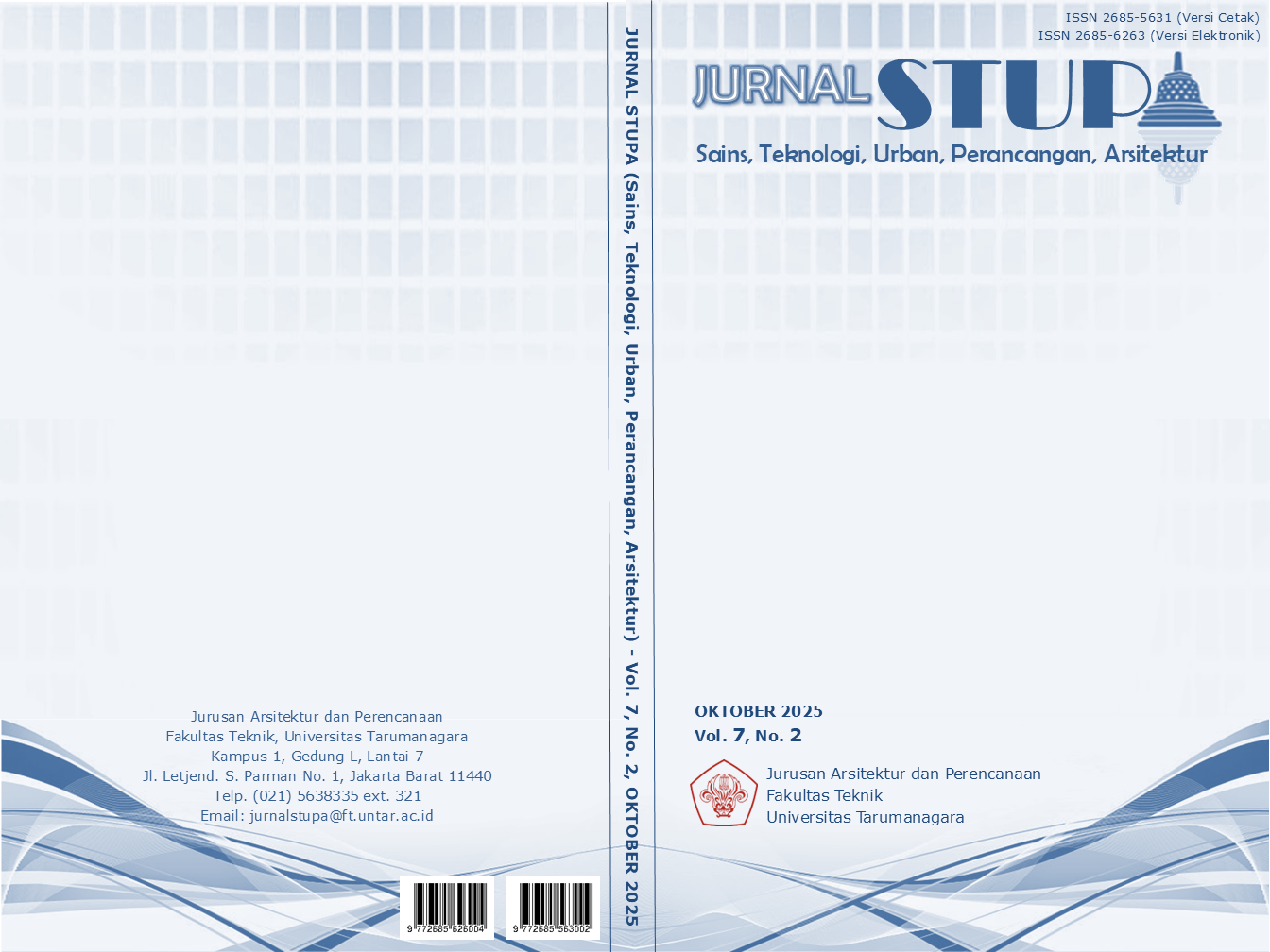PENERAPAN KONSEP REGENERATIF PADA PERANCANGAN TEMPAT PRODUKSI BATU BATA KERANG HIJAU DI CILINCING, JAKARTA UTARA
Isi Artikel Utama
Abstrak
Cilincing is an area in North Jakarta that borders directly on the sea. Despite having great potential for marine wealth, especially in the green mussel peeling industry, Cilincing is now a dense and slum area. The waters in the Cilincing area are relatively fertile due to the high population of phytoplankton, which is the main food source for green mussels. Local fishermen harvest green mussels, then process and sell the meat to markets or other areas. However, the remaining mussel shell waste is often dumped carelessly around residential areas or directly into the sea. This disposal has the potential to damage the marine ecosystem and pollute the waters. Therefore, solutions are needed, one of them is through the application of the concept of regenerative architecture. To explore more deeply the application of this concept, a qualitative descriptive approach was carried out that examined how the principles of regenerative architecture can be applied to production centre that aim to solve these environmental problems. The brick production centre from mussel shell waste was designed by prioritizing system integration, an ecological approach, and spatial experience, so that it not only solves the problem of waste accumulation, but also makes a positive contribution back to nature.
Keywords: brick production centre; green mussel processing; regenerative architecture
Abstrak
Cilincing merupakan kawasan di Jakarta Utara yang langsung berbatasan dengan laut. Meskipun memiliki potensi kekayaan laut yang besar, terutama dalam industri pengupasan kerang hijau, Cilincing kini justru menjadi area permukiman yang padat dan kumuh. Perairan di wilayah Cilincing tergolong subur karena tingginya populasi fitoplankton, yang menjadi sumber makanan utama bagi kerang hijau. Para nelayan setempat memanen kerang hijau, kemudian mengolah dan menjual dagingnya ke pasar atau daerah lain. Namun, limbah cangkang kerang yang tersisa sering kali dibuang secara sembarangan di sekitar permukiman atau langsung ke laut. Pembuangan ini berpotensi merusak ekosistem laut dan mencemari perairan. Oleh karena itu, dibutuhkan upaya penanggulangan yang tepat, salah satunya melalui penerapan konsep arsitektur regeneratif. Untuk menggali lebih dalam mengenai penerapan konsep ini, dilakukan pendekatan deskriptif kualitatif yang meneliti bagaimana prinsip-prinsip arsitektur regeneratif dapat diterapkan pada tempat produksi yang bertujuan memecahkan permasalahan lingkungan tersebut. Fasilitas produksi bata dari limbah cangkang kerang dirancang dengan mengedepankan integrasi sistem, pendekatan ekologi, dan pengalaman ruang, sehingga tidak hanya menyelesaikan masalah penumpukan limbah, tetapi juga memberikan kontribusi positif kembali kepada alam.
Rincian Artikel

Artikel ini berlisensiCreative Commons Attribution-NonCommercial-ShareAlike 4.0 International License.
This work is licensed under a Jurnal Sains, Teknologi, Urban, Perancangan, Arsitektur/ STUPA Creative Commons Attribution-NonCommercial-ShareAlike 4.0 International LicenseReferensi
Brown, M., Battisti, C. et al. (2021). Regenerative Guide for Educators, Students and Practitioners. RESTORD. COST Action CA16114 RESTORE, printed by Eurac Research (Bolzano, IT)
Dervishaj, A. (2023). From Sustainability to Regeneration: a digital framework with BIM and computational design methods. Archit. Struct. Constr. 3, 315–336. https://doi.org/10.1007/s44150-023-00094-9
Littman J.A. (2009). Regenerative Architecture: A Pathway Beyond Sustainability. Master Theses. Paper 303. University of Massachuttes Amherst.
Miodonski, I. (2023). Regenerative Architecture: The inspiration towards greater sustainability. École Polytechnique Fédérale de Lausanne.
Murdahayu, M. (2013). Influence of the Organic Waste and Its N/P Ratio to Phytoplankton Diversity at Cilincing Mussel Farming. Jurnal Teknologi Pengelolaan Limbah.
Putri, et al. (2023). Analisis Kandungan Logam Kadmium dan Timbal pada Kerang Hijau(Perna viridis) di Cilincing, Jakarta Utara. Fish Scientiae, 13(1).
UK Architects Declare. (2024) Climate – Biodiversity Emergency : Regenerative Design Primer. https://uk.architectsdeclare.com/resources.
Rini, T. (2019). Contents and Waste Handling of Green Shell Skin in Cilincing, North Jakarta. The 6th International Conference on Public Health Best Western Premier Hotel, 108. https://doi.org/10.26911/the6thicph-FP.01.14.
Reed, B. (2007). A Living Systems Approach to Design. AIA National Convention, May 2007 – Theme Keynote Address.



